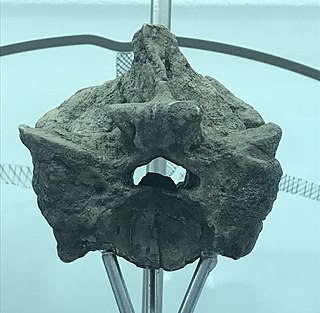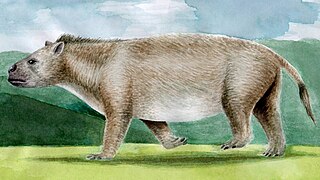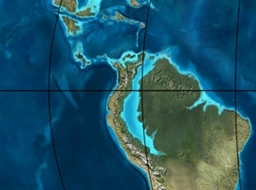
Xenungulata is an order of extinct and primitive South American hoofed mammals that lived from the Late Paleocene to Early Eocene. Fossils of the order are known from deposits in Brazil, Argentina, Peru, and Colombia. The best known member of this enigmatic order is the genus Carodnia, a tapir-like and -sized animal with a gait similar to living African elephants.
Hyposaurus is a genus of extinct marine dyrosaurid crocodyliform. Fossils have been found in Paleocene aged rocks of the Iullemmeden Basin in West Africa, Campanian–Maastrichtian Shendi Formation of Sudan and Maastrichtian through Danian strata in New Jersey, Alabama and South Carolina. Isolated teeth comparable to Hyposaurus have also been found in Thanetian strata of Virginia. It was related to Dyrosaurus. The priority of the species H. rogersii has been debated, however there is no sound basis for the recognition of more than one species from North America. The other North American species are therefore considered nomina vana.

Montrichardia is a genus of flowering plants in the family Araceae. It contains two species, Montrichardia arborescens and Montrichardia linifera, and one extinct species Montrichardia aquatica. The genus is helophytic and distributed in tropical America. The extinct species M. aquatica is known from fossils found in a Neotropical rainforest environment preserved in the Paleocene Cerrejón Formation of Colombia. Living Montrichardia species have a diploid chromosome number of 2n=48.

Titanoboa is an extinct genus of giant boid snake that lived during the middle and late Paleocene. Titanoboa was first discovered in the early 2000s by the Smithsonian Tropical Research Institute who, along with students from the University of Florida, recovered 186 fossils of Titanoboa from La Guajira department in northeastern Colombia. It was named and described in 2009 as Titanoboa cerrejonensis, the largest snake ever found at that time. It was originally known only from thoracic vertebrae and ribs, but later expeditions collected parts of the skull and teeth. Titanoboa is in the subfamily Boinae, being most closely related to other extant boines from Madagascar and the Pacific.
The Peligran age is a period of geologic time within the Paleocene epoch of the Paleogene, used more specifically with South American land mammal ages (SALMA). It follows the Tiupampan and precedes the Riochican age.

The Itaboraian age is a period within the Early Eocene geologic time epoch of the Paleogene, used more specifically with South American land mammal ages (SALMA). It follows the Riochican and precedes the Casamayoran age.
The Santa Lucía Formation is a Maastrichtian to Paleocene (Danian) geologic formation in Bolivia. Fossil ornithopod tracks have been reported from the Cretaceous lower part of the formation. It is the type formation of the Tiupampan South American land mammal age.
Cerrejonisuchus is an extinct genus of dyrosaurid crocodylomorph. It is known from a complete skull and mandible from the Cerrejón Formation in northeastern Colombia, which is Paleocene in age. Specimens belonging to Cerrejonisuchus and to several other dyrosaurids have been found from the Cerrejón open-pit coal mine in La Guajira. The length of the rostrum is only 54-59% of the total length of the skull, making the snout of Cerrejonisuchus the shortest of all dyrosaurids.

The Cerrejón Formation is a geologic formation in Colombia dating back to the Middle-Late Paleocene. It is found in the El Cerrejón sub-basin of the Cesar-Ranchería Basin of La Guajira and Cesar. The formation consists of bituminous coal fields that are an important economic resource. Coal from the Cerrejón Formation is mined extensively from the Cerrejón open-pit coal mine, one of the largest in the world. The formation also bears fossils that are the earliest record of Neotropical rainforests.
Cerrejonemys wayuunaiki is an extinct podocnemid turtle which existed in Colombia during the Paleogene period; the Middle to Late Paleocene epoch.
Petrocardium is an extinct genus of monocot plants in the family Araceae. At present it contains only two species Petrocardium cerrejonense and Petrocardium wayuuorum, the type species. The genus is solely known from the Middle to Late Paleocene, Cerrejón Formation deposits in Colombia.
Montrichardia aquatica is an extinct species of monocot plant in the family Araceae. M. aquatica is related to the living species M. arborescens and M. linifera. The species is solely known from the Middle to Late Paleocene, fossil-rich Cerrejón Formation in La Guajira, northern Colombia.
Acherontisuchus is an extinct genus of dyrosaurid neosuchian from Middle to Late Paleocene deposits of Colombia. The only known species is A. guajiraensis, whose name means "Acheron crocodile of the Guajira Peninsula".

Carbonemys cofrinii is an extinct giant podocnemidid turtle known from the Middle Paleocene Cerrejón Formation of the Cesar-Ranchería Basin in northeastern Colombia. The formation is dated at around 60 to 57 million years ago, starting at about five million years after the KT extinction event.
The Nanjemoy Formation is a geologic formation pertaining to both the Wilcox Group and the Pamunkey Group of the eastern United States, stretching across the states of Virginia, Maryland, and District of Columbia. The formation crops out east of the Appalachians and dates back to the Paleogene period. Specifically to the Ypresian stage of the Eocene epoch, about 55 to 50 Ma or Wasatchian in the NALMA classification, defined by the contemporaneous Wasatch Formation of the Pacific US coast.
The "Tuffeau" de Saint-Omer is a geologic formation in northern France. The sandstones of the formation, named after Saint-Omer, preserve bird and primate fossils dating back to the middle Thanetian age of the Paleocene epoch of the Paleogene period, dating to about 58 Ma.

Etayoa is an ungulate of the family Carodniidae in the order Xenungulata that lived during the Early Eocene in northern South America.

The Bogotá Formation (Spanish: Formación Bogotá, E1-2b, Tpb, Pgb) is a geological formation of the Eastern Hills and Bogotá savanna on the Altiplano Cundiboyacense, Eastern Ranges of the Colombian Andes. The predominantly shale and siltstone formation, with sandstone beds intercalated, dates to the Paleogene period; Upper Paleocene to Lower Eocene epochs, with an age range of 61.66 to 52.5 Ma, spanning the Paleocene–Eocene Thermal Maximum. The thickness of the Bogotá Formation ranges from 169 metres (554 ft) near Tunja to 1,415 metres (4,642 ft) near Bogotá. Fossils of the ungulate Etayoa bacatensis have been found in the Bogotá Formation, as well as numerous reptiles, unnamed as of 2017.

The Cesar-Ranchería Basin is a sedimentary basin in northeastern Colombia. It is located in the southern part of the department of La Guajira and northeastern portion of Cesar. The basin is bound by the Oca Fault in the northeast and the Bucaramanga-Santa Marta Fault in the west. The mountain ranges Sierra Nevada de Santa Marta and the Serranía del Perijá enclose the narrow triangular intermontane basin, that covers an area of 11,668 square kilometres (4,505 sq mi). The Cesar and Ranchería Rivers flow through the basin, bearing their names.








